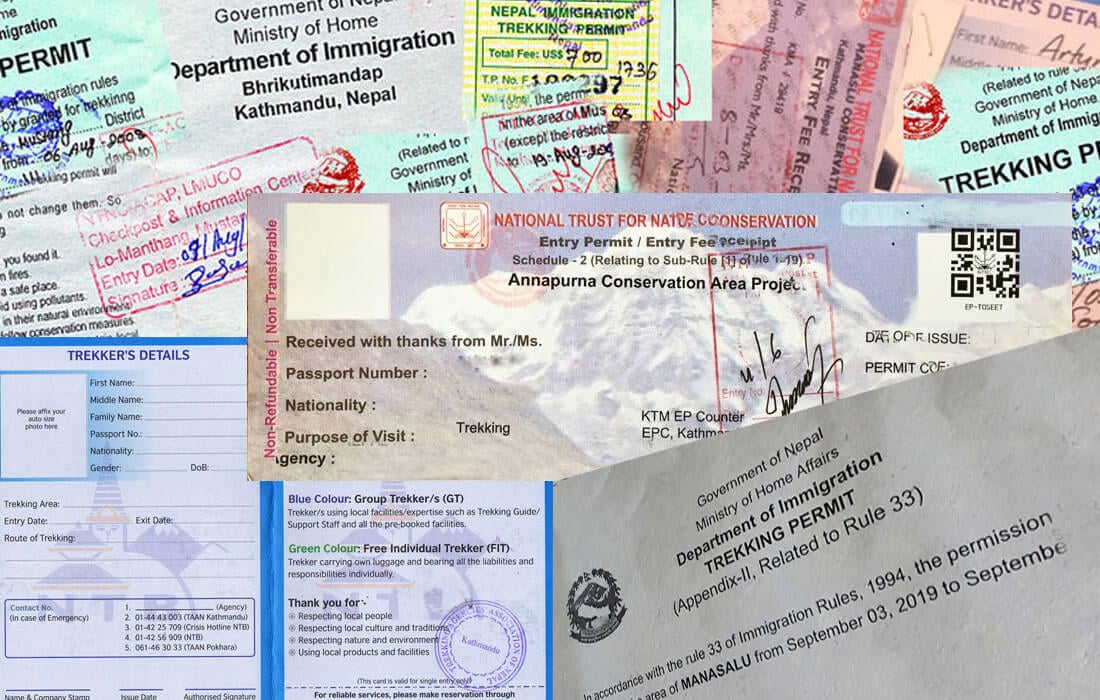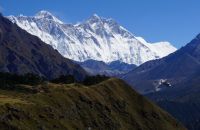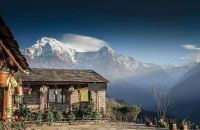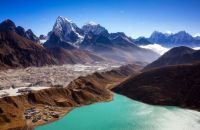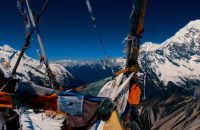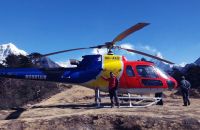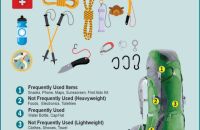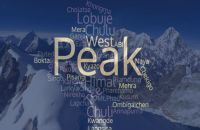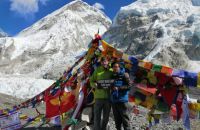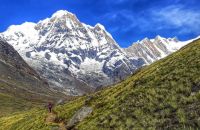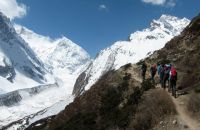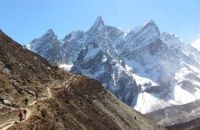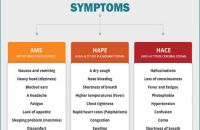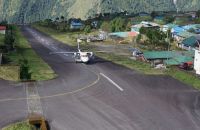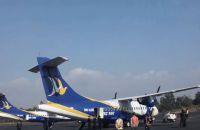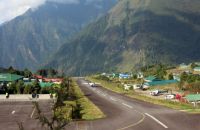Talk with our local travel specialist who can help organize your trip.
How to get TIMS card and trekking permits in Nepal
Before you embark on a trekking adventure, you need to organize your TIMS card and trekking permits in Nepal. If you’re planning on an organized trek, your trekking agency will deal with the permit paperwork. As per the revised TIMS card rule, effective from March 31, 2023, you must be accompanied by a licensed trekking guide and obtain a TIMS card through Government licensed trekking agency for 14 trekking regions including the Everest region.
The 14 trekking regions are Everest region, Annapurna region, Langtang region, Mustang region, Kanchenjunga region, Makalu Barun area, Rolwaling region, Panchpokhari Bhairabkunda area, Helambu region, Ganesh Himal - Ruby Valley Area, Manaslu region, Dhaulagiri region, Dolpo region, and Humla region.
Most newly arrived visitors to Nepal are keen to get out on the high mountain trails as soon as possible. But, before you lace up your hiking boots you need to organize your Nepal trekking permits. This article explains what you’ll need and how to get the various Nepal trekking permits paperwork done.
TIMS Card And Trekking Permits
The first official document you need, which is required for every Nepalese trek, is a TIMS (Trekkers Information Management System) card. This is essentially just so that the authorities know where in the mountains you’re headed and when. It’s fast and simple to obtain in either Kathmandu or Pokhara.
In Kathmandu, you get the TIMS card at the main tourist office on Pradarshani Marg, which is about a twenty-minute walk from the Thamel tourist area. The office is open daily from 9 am-5 pm (though there’s sometimes nobody around between about 1-2 pm). The latest you can make a permit application is 4 pm.
In Pokhara, the paperwork can all be obtained from the TAAN (Trekking Agencies Association of Nepal) Lakeside office in Santi Patan. Hours are the same as for the Kathmandu office.
You can obtain TIMS card from Nepal Tourism Board, Permit Nepal Trust, and Restricted area permit Immi of Nepal.
Trekking Information Management System (TIMS) Cost

The TIMS card costs NPR 1,000 for trekkers from SAARC countries(Citizens of South Asian countries) and NPR 2,000 for other country applicants. The TIMS cards generally only take half an hour or so to issue. In addition to the payment, you’ll also need to provide:
Require Documents TIMS Card
- Photocopy of your passport information pages
- Two passport-sized photos
You’ll also need to have the following information to hand:
- Start and end dates of your trek
- Entry and exit points for your trek
- Trek route and itinerary
- Insurance policy number and details of what the policy covers in terms of trekking at altitude. You’ll also need to supply the emergency phone number of the insurance company.
- Emergency contact number and address in Nepal (trekking company/hotel)
- Emergency contact number in your home country
What are the areas requiring TIMS and permits?

|
Trekking Region |
Name of the Trek |
|
Kanchenjunga Region |
1. Kanchenjunga Base Camp via Sele La Pass Trek |
|
Makalu Barun Area |
1. Makalu Basecamp Trek |
|
Everest Region |
1. Everest Basecamp Trek |
|
Rolwaling Region |
1. Rolwaling Trek |
|
Panchpokhari Bhairabkunda Area |
Panchpokhari Trek |
|
Helambu Region |
1. Helambu Trek |
|
Langtang Region |
1. Langtang Trek |
|
Ganesh Himal-Ruby Valley Area |
Ganesh Himal - Ruby Valley Trek |
|
Manaslu Region |
1. Manaslu Circuit Trek |
|
Annapurna Region |
1. Annapurna Circuit Trek |
|
Mustang Region |
1. Upper Mustang Trek |
|
Dhaulagiri Region |
Round Dhaulagiri |
|
Dolpo Region |
1. Upper Dolpo - Jomsom Trek |
|
Humla Region |
Humla Limi Valley Trek |
Source Nepal Tourism Board :https://ntb.gov.np/en/latest-travel-updates
Trekking Permits
In addition to the TIMS card for the majority of treks, you’ll also need to gather up a few other bits of paper. For the main trekking areas (Annapurna and Langtang), these are simply the relevant national park permits which can also be obtained at the same Kathmandu or Pokhara offices as the TIMS card. It’s sometimes possible to get national park permits at the entrance check posts to each park. However, we strongly recommend that you do not do this because if you can’t get one, it will likely be a long journey back to Kathmandu or Pokhara!
Trekking Permits Cost

Find below the cost of the trekking permits in Nepal.
| Trekking Region | Require Permits | Fees |
| Kanchenjunga Region | Kanchenjunga Conservation Area Fee | NRS. 2000 |
| TIMS Card | NRS. 2000 | |
| Special Restricted Area Permit | Required | |
| Makalu Barun Area | Makalu Barun National Park Fee | NRS. 3000 |
| TIMS Card | NRS. 2000 | |
| Local Municipality fee | NRS. 2000 | |
| Everest Region | Sagarmatha National Park Fee | NRS. 3000 |
| Local Municipality Fee | NRS. 2000 | |
| TIMS Card | NRS. 2000 | |
| Langtang Region | Langtang National Park Fee | NRS. 3000 |
| TIMS Card | NRS. 2000 | |
| Annapurna Region | Annapurna Conservation Area Fee | NRS. 3000 |
| TIMS Card | NRS. 2000 | |
| Mustang Region | Annapurna Conservation Area Fee | NRS. 3000 |
| TIMS Card | NRS. 2000 | |
| Restricted Area Permit | Required | |
| Manaslu Region | Manaslu Conservation Area Fee | NRS. 3000 |
| Annapurna Conservation Area Fee | NRS. 2000 | |
| Restricted Area Permit | Required | |
| TIMS Card | NRS. 2000 | |
| Rolwaling Region | Gaurisankar Conservation Area Fee | NRS. 3000 |
| TIMS Card | NRS. 2000 | |
| Panchpokhari Bhairabkunda Area | TIMS Card | NRS. 2000 |
| Helambu Region | TIMS Card | NRS. 2000 |
| Ganesh Himal-Ruby Valley Area | TIMS Card | NRS. 2000 |
| Dhaulagiri Region | TIMS Card | NRS. 2000 |
| Dolpo Region | TIMS Card | NRS. 2000 |
| Restricted Area Permit | Required | |
| Humla Region | TIMS Card | NRS. 2000 |
| Restricted Area Permit | Required |
- If you are trekking any National Park or Conservation Area, then you need to pay 3000 Nepalese Rupees (except Kanchenjunga) and TIMS Card 2000 Nepalese Rupees per person.
- For all Restricted Areas, you need to pay special Restricted Area permits (details check below) and National Park or Conservation fees as you travel.
National Parks, Conservation Area, Wildlife Reserve and Hunting Reserve Entrance Fees
| S.No. | Name | Category | SAARC | Foreigners | Child discount |
| 1 | Chitwan National Park | National Parks | NRs. 1,000 per person per entry | NRs. 2,000 per person per entry | Below 10 yrs free |
| 2 | Sagarmatha National Park | National Parks | NRs. 1,500 per person per entry | NRs. 3,000 per person per entry | Below 10 yrs free |
| 3 | Banke National Park | National Parks | NRs. 750 per person per entry | NRs. 1,500 per person per entry | Below 10 yrs free |
| 4 | Bardia National Park | National Parks | NRs. 750 per person per entry | NRs. 1,500 per person per entry | Below 10 yrs free |
| 5 | Khaptad National Park | National Parks | NRs. 500 per person per entry | NRs. 1,500 per person per entry | Below 10 yrs free |
| 6 | Langtang National Park | National Parks | NRs. 1,500 per person per entry | NRs. 3,000 per person per entry | Below 10 yrs free |
| 7 | Makalu-Barun National Park | National Parks | NRs. 1,500 per person per entry | NRs. 3,000 per person per entry | Below 10 yrs free |
| 8 | Parsa National Park | National Parks | NRs. 750 per person per entry | NRs. 1,500 per person per entry | Below 10 yrs free |
| 9 | Rara National Park | National Parks | NRs. 1,500 per person per entry | NRs. 3,000 per person per entry | Below 10 yrs free |
| 10 | Shey-Phoksundo National Park | National Parks | NRs. 1,500 per person per entry | NRs. 3,000 per person per entry | Below 10 yrs free |
| 11 | Shivapuri- Nagarjun National Park | National Parks | NRs. 600 per person per entry | NRs. 1,000 per person per entry | Below 10 yrs free |
| 12 | Shuklaphanta National Park | National Parks | NRs. 750 per person per entry | NRs. 1,500 per person per entry | Below 10 yrs free |
| 13 | Koshi Tappu Wildlife Reserve | Wildlife Reserve | NRs. 750 per person per entry | NRs. 1,500 per person per entry | Below 10 yrs free |
| 14 | Api Nampa Conservation Area | Conservation Areas | NRs. 500 per person per entry | NRs. 2,000 per person per entry | Below 10 yrs free |
| 15 | Annapurna Conservation Area | Conservation Areas | NRs. 1,000 per person per entry | NRs. 3,000 per person per entry | Below 10 yrs free |
| 16 | Blackbuck Conservation Area | Conservation Areas | NRs. 500 per person per entry | NRs. 2,000 per person per entry | Below 10 yrs free |
| 17 | Gaurishanker Conservation Area | Conservation Areas | NRs. 1,000 per person per entry | NRs. 3,000 per person per entry | Below 10 yrs free |
| 18 | Kanchenjunga Conservation Area | Conservation Areas | NRs. 500 per person per entry | NRs. 2,000 per person per entry | Below 10 yrs free |
| 19 | Manaslu Conservation Area | Conservation Areas | NRs. 1,000 per person per entry | NRs. 3,000 per person per entry | Below 10 yrs free |
| 20 | Dhorpatan | Hunting Reserve | NRs. 1,500 per person per entry | NRs. 3,000 per person per entry | Below 10 yrs free |
For more detail : Entrance Fee To Visit National Parks In Nepal
Restricted Area Permit

If you’re trekking in some of the country's lesser-trodden parts, you may have to obtain a Restricted Area Permit. In some cases, these Restricted Area Permits are fairly cheap and are fast to obtain (the Kanchenjunga area being a case in point). Still, in other trekking areas such as Upper Mustang and Upper Dolpo, they are very expensive indeed.
All Restricted Areas require you to be a part of an organized trek arranged through a licensed trekking company, but ‘organized’ can be as low-key as you, a companion, and a guide. Your trekking company will organize these permits for you (they’ll also organize your TIMS card and any national park permits required). Need minimum 2 people to get Restricted Area Permit.
The following is a non-comprehensive list of Restricted Area Permit costs and requirements:
|
S.No. |
Regions/VDCs |
Permit Fee |
|
1. |
Upper Mustang
|
USD 500 per person (for the first 10 days) USD 50 per person /Day (beyond 10 days) |
|
2. |
Upper Dolpo
|
USD 500 per person (for the first 10 days) USD 50 per person /Day (beyond 10 days) |
|
3. |
Gorkha Manaslu Area
|
September – November USD 100 per person/week USD 15 per person/day (beyond 1 week) December – August USD 75 per person/week USD 10 per person/day (beyond 1 week) |
|
4. |
Humla
|
USD 50 per person/week USD 10 per person/day (beyond 1 week) |
|
5. |
Taplejung
|
USD 20 per person/ week (for the first 4 weeks) USD 25 per person /week ( beyond 4 weeks) |
|
6. |
Lower Dolpo Area
|
USD 20 per person/ week USD 5 per person /week ( beyond 1 week) |
|
7. |
Dolakha
|
USD 20 per person/ week |
|
8. |
Gorkha Tsum Valley AreaSirdibas-Lokpa-Chumling-Chekampar-Nile-Chule
|
September – November USD 40 per person/week USD 7 per person/day (beyond 1 week) December – August USD 30 per person/week USD 7 per person/day (beyond 1 week) |
|
9. |
Sankhuwasabha
|
USD 20 per person/week (for the first 4 weeks) USD 25 per person/week (beyond 4 weeks) |
|
10. |
Solukhumbu
|
USD 20 per person/week (for the first 4 weeks) USD 25 per person/week (beyond 4 weeks) |
|
11. |
Rasuwa
|
USD 20 per person /week |
|
12. |
Manang
|
September – November USD 100 per person/week USD 15 per person/day (beyond 1 week) December – August USD 75 per person/week USD 15 per person/day (beyond 1 week) |
|
13. |
Bajhang
|
USD 90 per person/week for the first week USD 15 per person/day (beyond 1 week) |
|
14. |
Mugu
|
USD 100 per person/week USD 15 per person/day (beyond 1 week) |
|
15. |
Darchula
|
USD 90 per person/week USD 15 per person/day (beyond 1 week) |
Source: Nepal Tourism Board
Conclusion
If trekking outside of the main tourist seasons, for each trekking region, then permit and park entrance fees are sometimes reduced. SAARS citizens also pay less for park entry fees and TIMS cards but not for restricted area permits.
Whatever Nepal trekking permits you’ll need to complete before hitting the mountain trails, it’s best to allow a full day in Kathmandu to get everything sorted out at the start of your holiday. If you’re on an organized trek, your trekking agency will deal with all the required permit paperwork when you go sightseeing. Independent trekkers will need to do it alone, but it’s all pretty painless in most cases. Unfortunately, none of the Nepal trekking permits can be obtained at home before leaving for Nepal.
- Written by: Naba Raj Amgai
- Updated: Monday Mar 28, 2022

